Pushing back against the Chinese Communist Party’s coercive diplomacy
Posted By Fergus Hanson, Emilia Currey and Tracy Beattie on September 1, 2020 @ 06:00

Norwegian salmon, South Korean celebrities, Canadian pork and, most recently, Australian wine—the Chinese Communist Party’s coercive diplomacy over the past few years has spanned commodities and continents. However, countries’ responses have remained largely short-sighted and unilateral.
To bring some data to this debate, ASPI’s International Cyber Policy Centre’s latest report [1] compiles a dataset of 152 cases of coercive diplomacy between 2010 and 2020. The data shows a sharp escalation of the CCP’s use of economic and non-economic coercion since 2018. Yet the response of victim governments has so far been mostly flat-footed. The report aims to assist policymakers to develop a data-driven response that can push back effectively against the CCP’s increasing use of this practice.
The report looks at the CCP’s methods of coercive diplomacy under eight categories: arbitrary detention, restrictions on official travel, investment restrictions, trade restrictions, tourism restrictions, popular boycotts, pressure on specific companies, and state-issued threats.
The most common method used by the CCP against foreign governments has been state-issued threats. Warnings [2] of ‘countermeasures’, ‘retaliation’, ‘pain’ and ‘the right to further react’ made by Chinese diplomats, embassies, ministries and state-run media have become all too familiar. The issuing of such threats is the quickest and most cost-effective form of coercive diplomacy and carries the lowest risk to the CCP’s own interests, making it ideal to deploy immediately to address state conduct it wants to stop.
Trade and tourism restrictions are the second and third most recorded methods of coercive diplomacy, respectively. Contrary to some of the sensational media reporting that has been sparked by these coercive measures, it’s clear from the report’s dataset that the CCP is highly selective [3] in the commodities it targets. Its aim is to minimise the impact on its own interests while sending a powerful message to the target state.
A prominent example is the CCP’s selection of salmon for a ban in retaliation for the Norwegian Nobel Committee’s awarding of the Nobel Peace Prize to Chinese dissident Liu Xiaobo in 2010. Beyond any financial impact, the biggest driver was the power of the message sent by targeting a commodity that many Norwegians consider a ‘national symbol [3]’. The same has been said [4] of the CCP’s banning of South Korean celebrities in 2016 after South Korea decided to install the THAAD missile-defence system; the choice was intended to maximise the ‘symbolic and psychological impact of the sanctions’.
There are external constraints on the CCP’s use of economic coercion, as demonstrated in the measures taken against South Korea, Canada and Australia. In South Korea [5], exports to China actually increased in 2017 despite the widely publicised boycotts and tourism restrictions enacted by the CCP to punish South Korea over the THAAD decision. This was driven by China’s reliance on South Korean semiconductors.
In Canada [6], the CCP retracted its ban on Canadian meat imports—which was originally put in place in retaliation for the arrest of Huawei executive Meng Wanzhou—after an outbreak of swine fever severely diminished China’s domestic stocks of pork, despite the unresolved tensions over Huawei.
Similarly, Australia–China trade [7] increased by 4% in the first six months of 2020, despite the widely publicised restrictions on barley and beef in response to Australia’s call for a Covid-19 investigation.
The dataset also revealed some noticeable geopolitical trends. Australia and New Zealand, Europe, North America, and East Asia (South Korea, Japan, Taiwan) experienced the highest number of coercive diplomacy cases. Countries in Africa, South America, the Pacific islands and the remaining parts of Asia recorded the smallest number of cases. This divide bears many similarities to the divide between high-income and middle- to low-income countries as defined by the World Bank [8]. The most likely reason for this is that the political backers of China are predominantly in the developing world.
The standard reaction by states subjected to coercive diplomacy by the CCP was a bilateral one, which plays into the CCP’s hands by allowing it to retain its comparative strength. Repeatedly, states are failing to connect the dots and see the widespread use of the same tactics against allies and friends, who could be ready partners in a more effective, coordinated push-back.
The report argues that coordinated multilateral and minilateral push-back is key to forcing the CCP to wind back its increasing use of coercion.
More controversially, it also recommends that the Five Eyes countries (Australia, Canada, New Zealand, the UK and the US) adopt a collective economic security measure, analogous to Article 5 of the NATO treaty. Such a pact would enable them to use their collective intelligence arrangements to make authoritative joint attributions of coercive measures levied against any one member and facilitate collective economic and diplomatic responses.
Article printed from The Strategist: https://aspistrategist.ru
URL to article: /pushing-back-against-the-chinese-communist-partys-coercive-diplomacy/
URLs in this post:
[1] latest report: https://www.aspistrategist.ru/report/chinese-communist-partys-coercive-diplomacy
[2] Warnings: https://www.bbc.com/news/world-asia-china-50832915
[3] highly selective: https://www.brookings.edu/articles/chinese-non-military-coercion-tactics-and-rationale/
[4] has been said: https://jamestown.org/program/back-normal-end-thaad-dispute-china-south-korea/
[5] In South Korea: http://www.theasanforum.org/chinese-economic-coercion-during-the-thaad-dispute/
[6] In Canada: https://www.theglobeandmail.com/politics/article-china-says-lifting-of-meat-ban-not-a-sign-of-better-relations-with/
[7] Australia–China trade: https://www.smh.com.au/world/asia/australian-trade-with-china-surges-as-rest-of-the-world-falls-20200804-p55icy.html
[8] the World Bank: https://datatopics.worldbank.org/world-development-indicators/the-world-by-income-and-region.html
Click here to print.